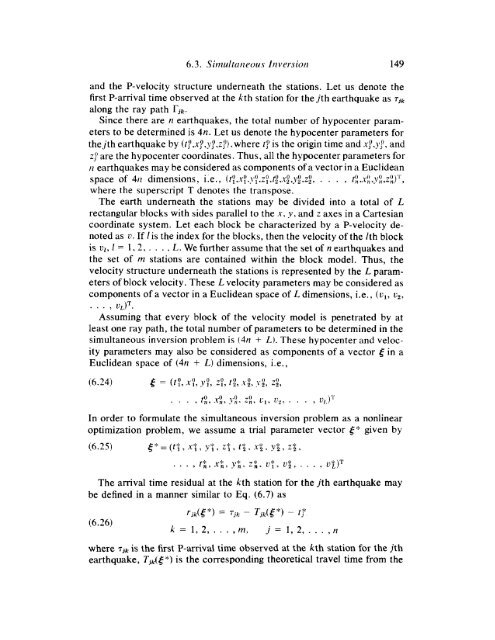principles and applications of microearthquake networks
principles and applications of microearthquake networks
principles and applications of microearthquake networks
Create successful ePaper yourself
Turn your PDF publications into a flip-book with our unique Google optimized e-Paper software.
6.3. Simul ta 11 eoirs Iii v ers ioti 149<br />
<strong>and</strong> the P-velocity structure underneath the stations. Let us denote the<br />
first P-arrival time observed at the kth station for thejth earthquake as T~~<br />
along the ray path rjk.<br />
Since there are n earthquakes, the total number <strong>of</strong> hypocenter parameters<br />
to be determined is 4n. Let us denote the hypocenter parameters for<br />
thejth earthquake by (tf,xf,yf,z~), where tf is the origin time <strong>and</strong> xy,yf, <strong>and</strong><br />
zf are the hypocenter coordinates. Thus, all the hypocenter parameters for<br />
iz earthquakes may be considered as components <strong>of</strong> a vector in a Euclidean<br />
space <strong>of</strong> 412 dimensions, i.e., ct~,s?..\.?.z~,f20,~vY20,YZO.zZO, . . . , t~,,vO,,yO,,z~)T,<br />
where the superscript T denotes the transpose.<br />
The earth underneath the stations may be divided into a total <strong>of</strong> L<br />
rectangular blocks with sides parallel to the x, Y, <strong>and</strong> z axes in a Cartesian<br />
coordinate system. Let each block be characterized by a P-velocity denoted<br />
as u. If I is the index for the blocks, then the velocity <strong>of</strong> the Ith block<br />
is ul, I = I, 2, . . . . L. We further assume that the set <strong>of</strong> n earthquakes <strong>and</strong><br />
the set <strong>of</strong> rn stations are contained within the block model. Thus, the<br />
velocity structure underneath the stations is represented by the L parameters<br />
<strong>of</strong> block velocity. These L velocity parameters may be considered as<br />
components <strong>of</strong> a vector in a Euclidean space <strong>of</strong> L dimensions, i.e., (ul, u2,<br />
... 7 VJT.<br />
Assuming that every block <strong>of</strong> the velocity model is penetrated by at<br />
least one ray path, the total number <strong>of</strong> parameters to be determined in the<br />
simultaneous inversion problem is (4n + L). These hypocenter <strong>and</strong> velocity<br />
parameters may also be considered as components <strong>of</strong> a vector & in a<br />
Euclidean space <strong>of</strong> (4n + L) dimensions, i.e.,<br />
In order to formulate the simultaneous inversion problem as a nonlinear<br />
optimization problem, we assume a trial parameter vector e* given by<br />
(6.25) e* = (t" 1, x;, y;, z;, f3, x3. y$, z:,<br />
. . . , t:, x;, y;, z;. o;, ?I$, . . . , ot)T<br />
The arrival time residual at the kth station for the jth earthquake may<br />
be defined in a manner similar to Eq. (6.7) as<br />
(6.26)<br />
rjk(e*) = T jk - Tj,(g*) - tf<br />
k = l , 2<br />
,..., rn, j = l , 2 ,..., n<br />
where 7jk is the first Farrival time observed at the kth station for the jth<br />
earthquake, Tjk(( 9 is the corresponding theoretical travel time from the






